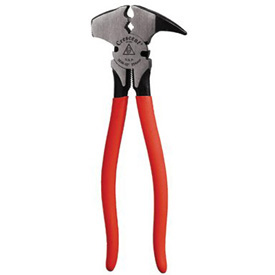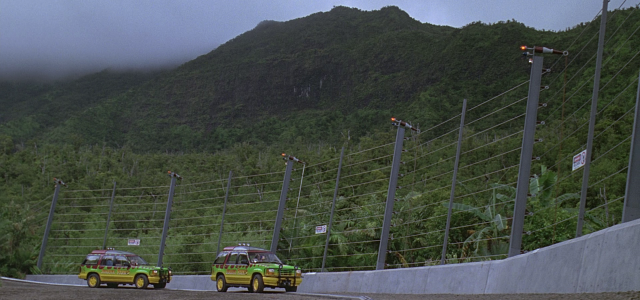Roughly 50% of funny homesteading stories start with “livestock broke out of the fence and then…” Whether the livestock gets in the road, craps on the neighbor’s Prius, or invades France, something weird usually ensues. It always happens at 2:00 am, in a rainstorm, on a holiday, when you’re not around. Things go downhill from there.
I’m a busy man and my bullshit tolerance is exceptionally low. So I decided to build a pig containment facility that was vast overkill for the task at hand. I felt that was a wise investment that hedges my bets against unforeseen future needs.
I call it the Jurassic Park theory, because those were some epic fences. Of course the theory doesn’t sound great if you reflect that in the movie the fences never worked and many people got eaten. Actually, now that I think about it “the fences never work” is an excellent lesson about homesteading.
Since the corral was made of totally awesome railroad ties with bitchin’ wood planks my work was mostly done. I’d already added shiny new gates too. All that was left to do was stop pigs from burrowing under the lowest plank (and at every gate). Pigs dig.
Ever spend many hours running “old school” electric fence line? I did. It sucks with a capital “S”.
I was too cheap to buy the small light modern filament shit. (I later regretted this.) I scrounged up some “scrap” two wire electric fencing from my forest (farmers leave shit everywhere… I’m still pulling metal out of every acre). I coiled it, straightened it, cut out any problem areas, hauled it to my corral, and set to work creating an incomplete circuit that’s just itching for a pig nose to complete the ground and addle his little porcine brain.
It was more work that I can possibly describe!
I ran the whole thing about 6” off the ground. Here’s a test. Six inches off the ground is the best way to string a fence because it’ll:
- Fry the nose of a large burrowing mammal. (It’s not like a fat pig is going to climb over the fence.)
- Twist your back into a pretzel.
- Tangle the wire, which is supposed to be bare and untouched, with every weed, grass, and bramble in sight.
You’re thinking “all of the above”? Wrong! The best way to string fence is to pay someone else to do it and go back to stacking firewood. Have I mentioned that it was a huge pain in the ass? Unfortunately I do everything myself if I can possibly manage it. Sometimes I do things for myself when I can’t manage it. (For example, there probably won’t be corn this year.) I’m pretty sure if I were referred to a brain surgeon my first thought would be “is there a book on this somewhere? How hard can it be?
A smart person probably wouldn’t build onto existing stuff. They would buy all new materials (which are flimsy but much easier to use) and put it out all at once. A suitable pig pen could probably be assembled from new materials on my flat lawn (which I’m sick of mowing anyway) in 2 hours while sipping iced tea. That would have been 1000% easier. My method of adapting a railroad tie corral with six gates was maximum effort.
That said the final fence is pretty hard core. Aside from the transformer, I spent less than $30. I did it mostly in one day. It was a hard day but it didn’t take weeks. I did it all by myself. It’s not rocket science.
By the way the proper use of fencing pliers is an art and stout wire will do a job on your hands. I’m just sayin’.

Buy one of these. Even if you don’t know what to do with it, you need one. Buy a spare because you’ll lose one in the brush and find it a few months later with your lawnmower.
More details: If you read on the Internet about electric fences you’ll see about eleven million bits and pieces and many more ways to assemble them. Books, plans, etc… They advise careful planning and thinking about materials and the animal in question and as far as I can tell hiring a team of Harvard Professors. Bah!
If you’re adapting pre-existing stuff don’t do it like that. You’re thinking too hard! Instead buy some random shit, drop it in a pile on the truck tailgate, and see what happens. I over thought it too long. After I got started I just started at point A and adapted to corners, gates, etc… as I went. It turned out to be easier that way.
As always, I just did one area and folks who do hundreds of acres will have greater wisdom. They probably also have better tractors.


Okay. I was just waiting for the digging part when I read about the corral. I also tried the low electric line. I now also have about two tons of rocks, because Australian pigs (or at least these saddlebacks) ain’t woosies your pigs, and just squeal in advance (and seem genius at shorting the damn thing out.) I’ve got a new technique, which involves tossing a few handfuls of corn int the middle of their pen, when I feed them. They spend hours hunting every last grain, and digging for it… In the middle of the pen, where this is harmless. Most of my disasters involve burst pipes at 2 AM or touching the electric fence with my rifle. No escaped livestock so far, although I’ve had game breaking in.
With all this investment have you figured out the price per rasher yet?
The unit is “per pig” and the price is “as much as the market will bear”.
That said if someone wants to pay me so much per “rasher” that I can keep the rest of the pig and eat BBQ ribs all day I’m going to laugh all the way to the bank.
Can’t believe that you think an electric fence will keep a bunch of pigs in indefinitely. Lol you’ll have fun with that!
It’s a huge wooden corral with electricity too and it surrounds an area with room for ten times as many pigs… plus I feed them tons and they’ve got grass and a sprinkler and everything.
Do you need a wall to keep fat tourists in Club Med?
I gave them strawberries and popcorn this morning (leftovers)… they’re happy pigs.
I keep thinking that if I ever want to have kids, I need to make sure I’ve got room to raise chickens, pigs, and rabbits.
For, of course, eggs, bacon, and traumatizing them out of any squeamishness.
Also so they can tell stories of the horrible Dickensonian upbringing they had. “We grew up in a dirt shack with six pigs and only one Nintendo Wii.”
Pingback: Bacon Update: Part 1 | The Adaptive Curmudgeon's Blog